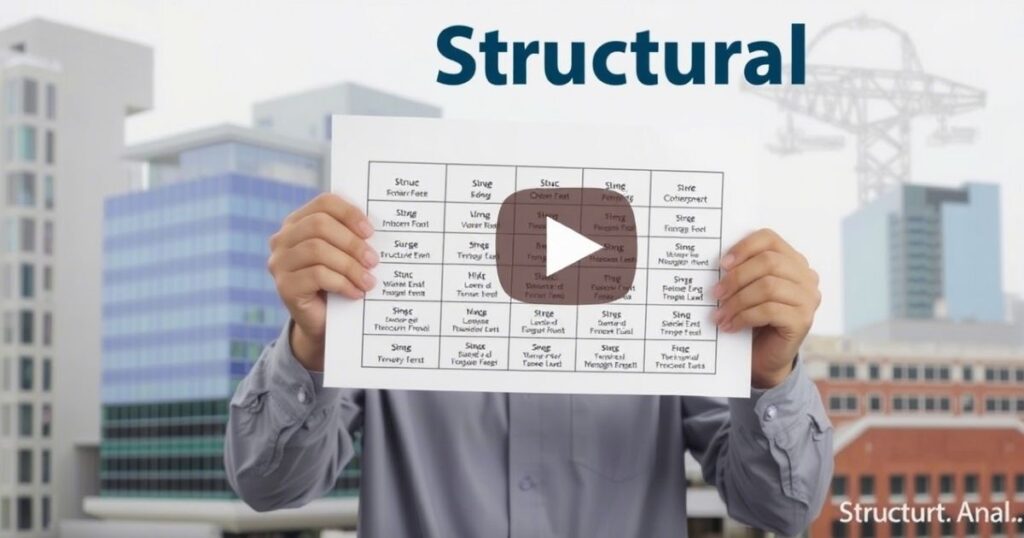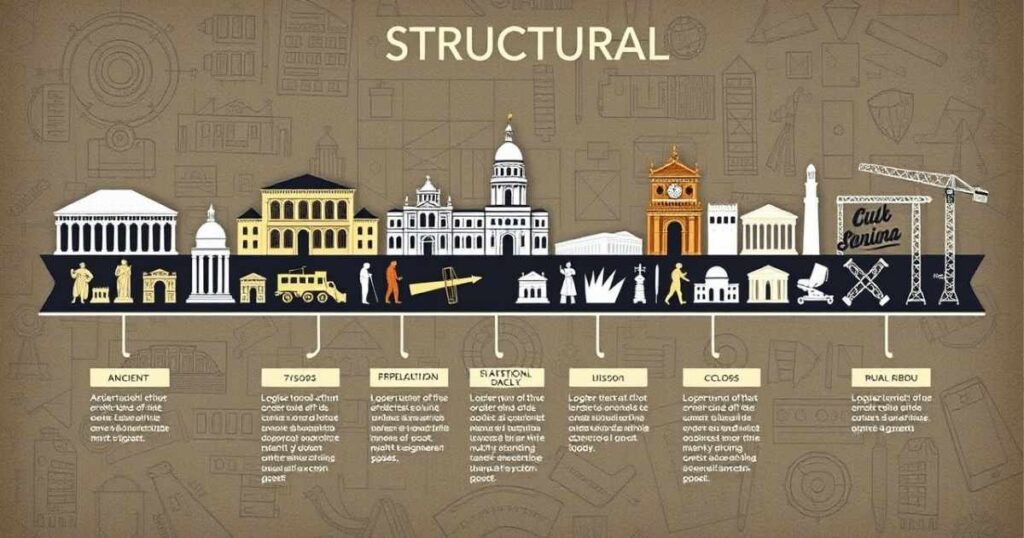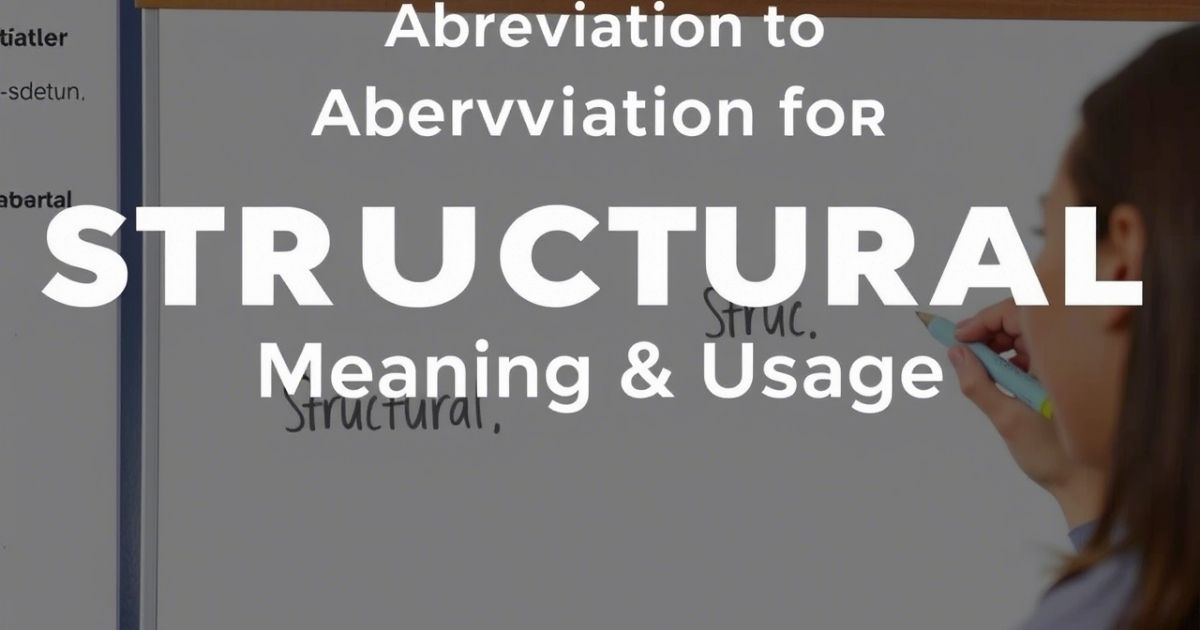The abbreviation for Structural is a useful shorthand often seen in engineering, architecture, and construction. Using an abbreviation for Structural helps save space and make technical writing clear and efficient. Common forms like “Struct.”, “STR”, and “STRL” appear in blueprints, reports, and design documents. These short forms allow professionals to focus on details without repeating long words. You’ll often find the abbreviation for Structural used in structural engineering, building plans, and technical specs. It’s a quick way to refer to anything related to a structure or framework.
Understanding the abbreviation for Structural makes reading technical documents much easier. Whether you’re looking at structural design, support systems, or framework layouts, this abbreviation keeps things simple. You’ll see the abbreviation for Structural in engineering drawings, construction notes, and architecture guides. Learning these terms saves time and improves clarity in real-world projects. So, when working in technical fields, always recognize and use the right abbreviation for Structural.
What is the Abbreviation for Structural?
The most common abbreviation for Structural is ‘Struct.’ In certain industries like engineering, construction, or architecture, you may also encounter it as ‘STR’ or ‘STRL.’ These shortened forms are particularly useful in technical documents where conciseness is key.
For example:
- Struct. Engineer – Structural Engineer
- STR Analysis – Structural Analysis
- STRL Framework – Structural Framework
These abbreviations help to streamline communication, especially in blueprints, project plans, and other detailed documents.
When Do We Use These Abbreviations?
You’ll typically find these abbreviations in:
- Construction blueprints and architectural plans
- Engineering reports and technical documents
- Project schedules and specifications
However, in casual or general writing, it’s recommended to use the full word ‘Structural’ to prevent any misunderstandings or ambiguity.
What Does Abbreviation for Structural Mean?

At its core, the abbreviation for Structural refers to a shortened form of the word used in technical fields like construction, engineering, and architecture. It is commonly employed to simplify communication in complex documents where space is limited.
Example Sentences:
- The Struct. Eng. is analyzing the building’s framework.
- The STR Design plan outlines the structural layout of the project.
- This abbreviation helps professionals convey important details quickly and efficiently.
The term highlights elements related to a structure, emphasizing the organization or arrangement of parts, whether in a building or a design.
How Do You Pronounce Structural?
The word “Structural” is pronounced as:
/ˈstrʌk.tʃɚ.əl/ – in American English
/ˈstrʌk.tʃər.əl/ – in British English
It sounds like: STRUK-chur-uhl (three syllables)
Here’s a quick breakdown:
- STRUK – rhymes with “truck”
- chur – like “church” without the “ch”
- uhl – a soft “uhl” sound, like in “cultural”
It rolls off naturally when talking about buildings, frameworks, or anything related to how something is built or organized.
Abbreviations in Structural Drawings and Blueprints
In construction drawings and blueprints, abbreviations are indispensable for organizing and communicating complex information. Labels like “STR” often prefix drawing numbers, indicating that the sheet belongs to the structural discipline. This categorization helps contractors, engineers, and architects navigate large drawing sets efficiently.
Symbols and tags within the drawing may also use abbreviated terms. For example, “STR BM” could indicate a structural beam, while “STR CL” might stand for a structural column. Using these consistent abbreviations makes it easier for builders and engineers to interpret the drawing correctly without requiring detailed explanations on every page.
Most architectural and engineering firms follow standardized conventions or use a legend on the drawings to define any abbreviations used. These standards are not only about saving space they also support regulatory compliance and reduce the risk of on site errors.
What Does “Structural” Mean in Engineering and Design?
In the context of engineering and architecture, “structural” refers to elements or systems that contribute to the strength and stability of a building or infrastructure. These elements are designed to bear loads, resist forces, and ensure that the structure remains intact and safe for use. Common examples include beams, columns, foundations, and trusses.
Structural considerations are central to ensuring safety, compliance with codes, and the longevity of any construction. Engineers and architects must calculate load-bearing capacities, potential stress points, and the behavior of materials under pressure. This makes the term “structural” more than just descriptive it reflects a critical category of responsibility in design and construction.
Because the term appears frequently in reports, drawings, and communication among professionals, using abbreviations saves time and space. This frequent use has led to a variety of shorthand notations being adopted across the industry.
Related Guide:
Common Abbreviation for Breakfast Explained
Industry Standards for Structural Abbreviations
Many industry standards help ensure uniform use of abbreviations in structural engineering, especially in the context of large construction projects. Organizations like the American Institute of Architects (AIA), Construction Specifications Institute (CSI), and local engineering boards provide guidelines on abbreviations for various building components.
These standards often include comprehensive lists of accepted abbreviations, such as “STR” for structural, “STL” for steel, and “RC” for reinforced concrete. Adhering to these standards ensures that engineers, contractors, and reviewers are all on the same page literally and figuratively.
While firms may develop their own internal standards, aligning with industry norms minimizes confusion when working with external teams. Standardization also improves regulatory review processes and ensures consistency across multiple phases of construction and documentation.
Short Abbreviation for Structural
A short abbreviation for Structural includes:
- Struct. – Most common and widely recognized
- STR – Often used in engineering documents and drawings
- STRL – Seen in technical plans or software systems
These abbreviations are helpful for saving space in blueprints, design notes, and engineering reports while keeping communication clear and professional.
Synonyms and Antonyms of Structural
Synonyms for Structural include architectural, constructional, and framework-related—terms that reflect something built or organized.
Antonyms would be nonstructural or decorative, referring to elements not essential to a structure’s support or design.
Synonyms:
- Architectural
- Framework
- Constructive
- Supportive
- Structuralized
Antonyms:
- Nonstructural
- Decorative
- Superficial
- Ornamental
- Unrelated
History of the Word Abbreviation for Structural

The abbreviation for structural has evolved significantly over time. Initially, it was primarily used in engineering and architectural fields to simplify communication. Over the years, various industries adopted the term, standardizing its usage to make technical discussions more efficient.
In the early 20th century, the abbreviation for structural began appearing more frequently in blueprints and construction documents. This abbreviation helped professionals save time while ensuring that detailed plans and specifications were understood without lengthy descriptions. As technology advanced, the need for concise communication in the field grew, leading to more widespread use.
Today, the abbreviation for structural is an essential part of construction and engineering language. It is commonly used in project plans, legal documents, and technical drawings. This shift towards brevity helps maintain clarity in complex discussions, streamlining the process of understanding structural designs and components.
Common Abbreviations for “Structural”
Several abbreviations for “structural” are used in different disciplines and regions. The most common ones include “STR,” “STL,” and simply “S.” These abbreviations appear in technical drawings, engineering documentation, and project specifications to denote structural components or disciplines.
“STR” is typically used in professional reports and CAD drawings to refer to the structural engineering discipline. “STL” might also be used, especially in manufacturing or structural steel contexts. “S” is often seen as a quick label on drawings to indicate a structural sheet or component, especially when distinguishing between disciplines like “A” for architectural or “M” for mechanical.
The choice of abbreviation often depends on the firm’s internal standards or the region’s preferred practices. While there’s no universal rule, clarity and consistency within a project are vital.
When Should You Use the Abbreviation for Structural?
You should use the abbreviation for Structural when writing in professional, technical, or industry-specific contexts where clarity and space are important.
- In blueprints, engineering plans, and architectural drawings to keep labels concise
- In technical reports or project specs where repeated use of the word would clutter the document
- In software tools or data charts where character limits or formatting space is limited
In everyday writing or general communication, it’s best to stick with the full word “Structural” to avoid confusion.
Real Life Example

In a construction project, an engineer might label sections of a blueprint like this:
- Struct. Beam A12 – referring to a specific structural beam
- STRL Support Details – indicating where to find the structural support specifications
- STR Analysis Report – the document analyzing the building’s structural stability
These abbreviations help professionals communicate quickly and clearly, especially on fast-paced job sites or in detailed technical documents.
FAQ’s
What does “Structural” refer to in technical fields?
In technical fields, Abbreviation for Structural is used to simplify long terms like structural engineering or structural analysis. It’s widely used in blueprints and reports.
Where can you find this abbreviation in professional documents?
You’ll often spot Abbreviation for Structural in construction documents, engineering plans, and architectural designs. It helps save space and makes the text clearer.
Why is this abbreviation important in construction and engineering?
Using the Abbreviation for Structural allows professionals to streamline complex documents, ensuring quick understanding while maintaining precision in technical details. It saves valuable time.
When should you use the shortened form for structural terms?
Use the Abbreviation for Structural in technical drawings, project proposals, and specifications where space is limited. It’s ideal for reports or presentations as well.
Is this abbreviation used outside of the engineering field?
Though the Abbreviation for Structural is common in engineering, it is also used in architecture and construction. It’s a standard in any framework-related field.
Conclusion
The abbreviation for Structural is commonly used in fields like architecture, construction, and engineering to keep communication simple and efficient. You’ll often see the abbreviation for Structural written as Struct., STR, or STRL in blueprints, building designs, and engineering reports. These abbreviations save space and reduce clutter, especially when referring to structural elements like beams, columns, or framework. In technical manuals and construction plans, the abbreviation for Structural helps professionals quickly identify important components.
Using the abbreviation for Structural is especially helpful in structural engineering, project specs, and support system layouts. Whether you’re reviewing a technical drawing or writing a research paper, these abbreviations make reading and writing faster. The abbreviation for Structural appears often in architectural designs, framework documentation, and analysis reports. By learning how and when to use the abbreviation for Structural, you make professional communication clearer and more accurate in everyday work.

Atlas Reid is an experienced administrator with 5 years of expertise in managing operations, streamlining processes, and ensuring efficiency. Skilled in leadership, organization, and problem-solving to drive business success.








